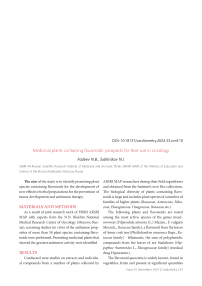Medicinal plants containing flavonoids: prospects for their use in oncology
Автор: Fadeev N.B., Sidelnikov N.I.
Журнал: Cardiometry @cardiometry
Статья в выпуске: 33, 2024 года.
Бесплатный доступ
The aim of the study is to identify promising plant species containing flavonoids for the development of new effective herbal preparations for the prevention of tumor development and antitumor therapy.
Medicinal plants, flavonoids, oncology
Короткий адрес: https://sciup.org/148329776
IDR: 148329776 | DOI: 10.18137/cardiometry.2024.33.conf.10
Текст статьи Medicinal plants containing flavonoids: prospects for their use in oncology
FSBRI All-Russian Scientific Research Institute of Medicinal and Aromatic Plants (ARSRI MAP) of the Ministry of Education and Science of the Russian Federation, Moscow, Russia
The aim of the study is to identify promising plant species containing flavonoids for the development of new effective herbal preparations for the prevention of tumor development and antitumor therapy.
MATERIALS AND METHODS
As a result of joint research work of FSBRI ARSRI MAP with experts from the N.N. Blokhin National Medical Research Center of Oncology (Moscow, Russia), screening studies ( in vitro ) of the antitumor properties of more than 50 plant species containing flavonoids were performed. Promising medicinal plants that showed the greatest antitumor activity were identified
RESULTS
Conducted were studies on extracts and individual compounds from a number of plants collected by
ARSRI MAP researchers during their field expeditions and obtained from the Institute’s own Bio-collections. The biological diversity of plants containing flavonoids is large and includes plant species of a number of families of higher plants ( Rosaceae , Asteraceae , Faba-ceae , Elaeagnaceae , Onagraceae, Rutaceae etc.).
The following plants and flavonoids are noted among the most active: species of the genus meadowsweet ( Filipendula ulmaria (L.) Maxim., F. vulgaris Moench., Rosaceae family), a flavonoid from the leaves of Amur cork tree ( Phellodendron amurence Rupr., Ru-taceae family) - fellamurin, the sum of polyphenolic compounds from the leaves of sea buckthorn ( Hip-pophae rhamnoides L., Elaeagnaceae family) (medical drug Hyporamin).
The flavonoid quercetin is widely known, found in vegetables, fruits and present in significant quantities
Issue 33. November 2024 | Cardiometry | 29
in many medicinal plants [1]. Its dose-dependent antitumor and antimetastatic effects have been shown, which are produced by generating reactive oxygen species, stopping the cell cycle, apoptosis, necrosis, autophagy, suppressing cellular bioenergetics and neoangiogenesis [2].
It is noteworthy that numerous examples show a direct correlation between the antiviral and antitumor activity of plant biologically active compounds. For example, flavonoid-containing plants of the genera Filipendula, Phellodedron , Hippophae have antiviral activity [1,3], and their extracts have shown experimental activity against various types of tumors [2].
The potential for the use of gallo-ellagic tannins from the herb rosebay willowherb, or narrow-leaved fireweed ( Epilobium angustifolium L. Scop., сем. Ona-graceae ) in oncology has been demonstrated [1,4], which also make an antiviral effect [1]. It can be assumed that the antitumor effect of flavonoids can be enhanced by systemic effects caused by their immunomodulatory properties.
The extract of the leaves of the Amur cork tree ( Ph. amurence Rupr) of the Rutaceae family contains the flavonoid fellamurin and is used as an antiviral and antihepatotoxic drug Flacoside [1], developed by ARSRI MAP. At the same time, fellamurin suppresses the growth of osteosarcoma tumors, induces apoptosis and inhibits the PI3K/AKT/mTOR pathway in vivo.
A series of studies were conducted by the N.N. Petrov National Medical Research Center of Oncology that demonstrated a pronounced preventive effect of the extract of the flavonoid-containing plant F. ulmaria in relation to chemical and radiation carcinogenesis [2]. These data allow us to consider biologically active compounds from the flowers of F. ulmaria as means of prevention, rehabilitation and accompanying treatment of cancer patients, especially children and elderly patients. F. vulgaris Moench. is a component of the antitumor collection according to Zdrenko’s prescription, recommended as a medicine in papillomatosis of the bladder [1].
Experience in the use of plants containing flavonoids in practical medicine by experts of the Phyto-therapeutic Society (Moscow) and the St. Petersburg Society of Therapists named after S.P. Botkin (Phytotherapy Section) allows us to recommend plants with antitumor and antiviral activity as an accompanying agent, significant for practical phytotherapy in oncology.
CONCLUSION
The prospects of research in the field of identification of new species of plants of the world flora containing flavonoids for the development of effective phytopreparations that can be used in complex antitumor therapy, both as direct inhibitors of tumor growth and as effective modulators of the immune system, promoting the activation of the body’s antitumor resistance, have been shown herein.
Список литературы Medicinal plants containing flavonoids: prospects for their use in oncology
- Atlas of medicinal plants of Russia. 2nd edition, revised and supplemented. under the general editorship of Sidelnikov N.I. Moscow: Nauka. 2021;646.
- Kit OI, Zhukova GV, Tolkachev ON, et al. Antitumor factors of natural origin and some approaches to the development of effective herbal therapy regimens in oncology. Issues of Oncology. 2022;68(5):527-38. DOI: 10.37469/0507-3758-2022-68-5-527-538
- Tolkachev ON, et al. Method for obtaining the antiviral drug "giporamin". Patent RU 2098111 C1. 1997.
- Sasov SA, Totoeva NN, Tolkachev VN, et al. Hydrolyzable gallo-ellagic tannins of fireweed (Chamaenerion angustifolium (L.) from the biocollection of the nursery of the botanical garden of the Federal State Budgetary Scientific Institution VILAR - a promising source for obtaining cytotoxic agents. Issues of Biological, Medical and Pharmaceutical Chemistry. 2019; 22(1): 28-34. 10.29296/25877313-2019- 01-04. DOI: 10.29296/25877313-2019-01-04


